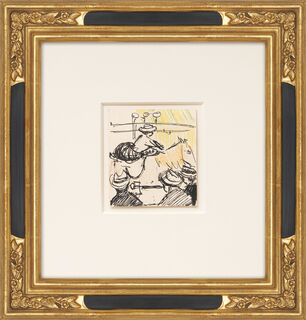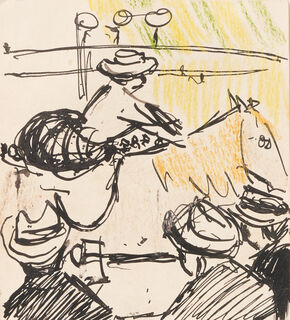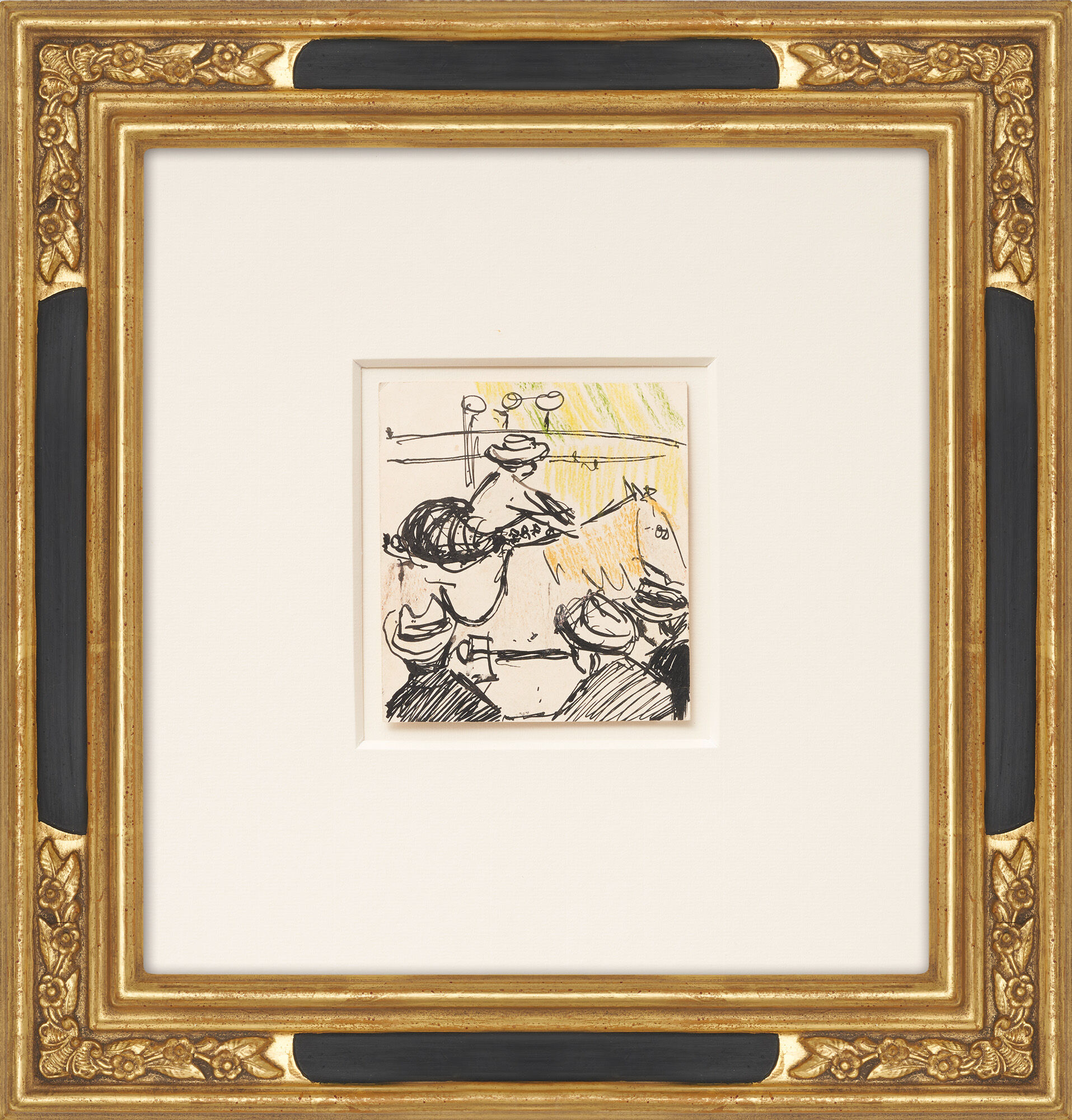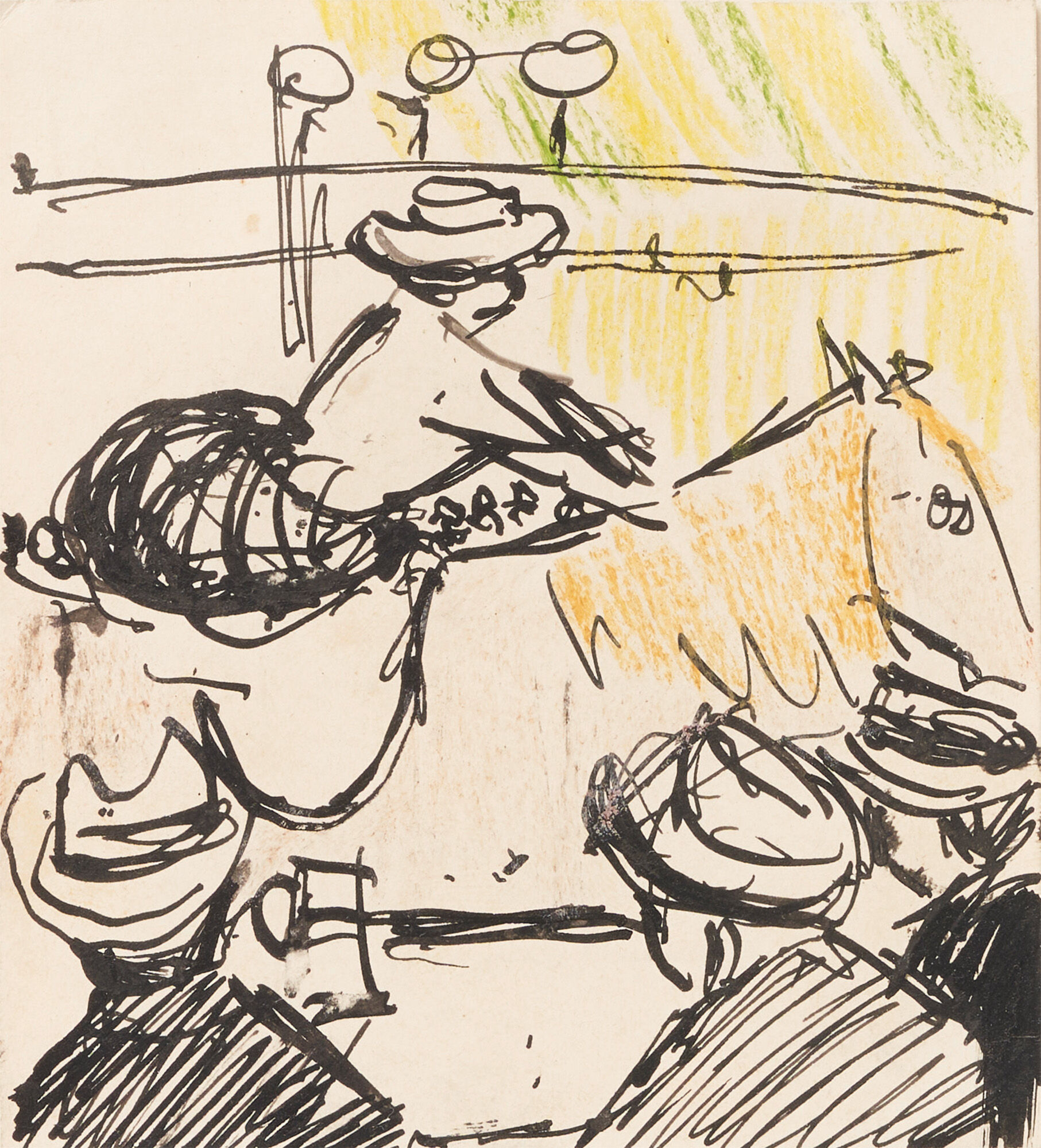Picture "Circus Rider" (1907) (Unique piece)


Picture "Circus Rider" (1907) (Unique piece)
Quick info
unique piece | stamped | pen and chalk drawing on paper | framed | size 40 x 34 cm
Detailed description
Picture "Circus Rider" (1907) (Unique piece)
Clear the ring! In this drawing, Ernst Ludwig Kirchner devoted himself to a classic circus scene: an artist rides a horse, observed by three spectators. The "Brücke" artist and pioneer of German Expressionism was a great admirer of acrobatics and visited the circus as often as possible. He was interested in more than just the circus experience itself; he gathered impressions here for his artistic work. He paid particular attention to the movements of the artists.
The technique of drawing was an important tool for Kirchner: He often carried a small sketchbook with him in which he could record impressions and situations with quick strokes at any time. He later elaborated on the content of these studies in his studio. Kirchner created this drawing of a circus rider in 1907 - and thus still during his time in Dresden. Even after he moved to Berlin in 1911, he frequently used the themes of the circus and vaudeville in his works.
Pen-and-ink drawing with coloured chalk on paper, 1907. Stamped on the back: Nachlass E. L. Kirchner Fs Dre/Be7. Motif size/sheet size 11.5 x 10.5 cm. Size in frame 40 x 34 cm as shown.
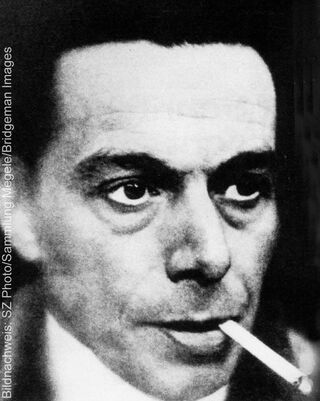
About Ernst Ludwig Kirchner
1880-1938
Ernst Ludwig Kirchner was one of the founders of the artist‘s group "Die Brücke" (The Bridge) and one of the most important representatives of Expressionism. His oeuvre includes around 30,000 paintings, drawings, sketches and sculptures.
When a person's fear becomes too great and the purpose of life is not only threatened but also taken away, it is often only seen one way out: self-chosen death. This is what happened to Ernst Ludwig Kirchner, who took his own life by gunshot on a mountain pasture above Davos on 15 June 1938. Before that, however, he destroyed his woodblocks and a large number of his sculptures out of fear of the invasion of German troops.
Kirchner was born in Aschaffenburg, Germany, on 6 May 1880 but moved to Switzerland on 13 October 1918. After several stays in sanatoriums because of severe depression and drug abuse in Germany, his friends admitted him to the doctor Ludwig Spengler in Davos.
The First World War, for which Kirchner volunteered for military service, triggered his anxiety. His "Self-Portrait as a Soldier" of 1915 was a testimony to his inner state of mind.
Kirchner was a painter who always reproduced his immediate surroundings in oil, woodcut, etching and also sculpture. Therefore, his work is structured through several phases. As a co-founder of the artist‘s group "Die Brücke" in 1905, he represented a strongly colourful and expressive style of painting, the themes of which are mainly the so-called "quarter-hour nudes" as well as city scenes of Dresden and Berlin. With the "discovery" of open-air painting, the nudes moved from the studio to the open air, in 1904 to the Moritzburg lakes, and from 1908 to Fehmarn.
After the ending of the group "Die Brücke" in 1913, Kirchner chose Berlin street scenes as a new motif, depicting the milieu of the cocottes with hard strokes and black outlines. For a long time, a critical view of the fringe groups of society took over from his paradisiacal landscape painting.
It was not until he returned to Switzerland that he found inner peace and equilibrium. His Swiss paintings of the 1920s are captivating for their colour harmonies and flowing forms.
In addition to painting and graphic art, the artist, who lived in an alpine hut, also devoted himself to sculpture. However, the National Socialists' seizure of power and the defamation of 639 of his works as "degenerate art" once again fuelled the fears of the sensitive artist and led him to his tragedy.
Depiction of typical scenes from daily life in painting, whereby a distinction can be made between peasant, bourgeois and courtly genres.
The genre reached its peak and immense popularity in Dutch paintings of the 17th century. In the 18th century, especially in France, the courtly-galant painting became prominent while in Germany the bourgeois character was emphasised.
A one-of-a-kind or unique piece is a work of art that has been personally created by the artist. It exists only once due to the type of production (oil painting, watercolours, drawing, etc.).
In addition to the classic unique pieces, there exist the so-called "serial unique pieces". They present a series of works with the same colour, motif and technique, manually prepared by the same artist. The serial unique pieces are rooted in "serial art", a type of modern art, that aims to create an aesthetic effect through series, repetitions and variations of the same objects or themes or a system of constant and variable elements or principles.
In the history of arts, the starting point of this trend was the work "Les Meules" (1890/1891) by Claude Monet, in which for the first time a series was created that went beyond a mere group of works. The other artists, who addressed to the serial art, include Claude Monet, Piet Mondrian and above all Gerhard Richter.

